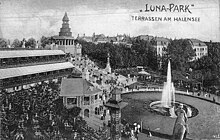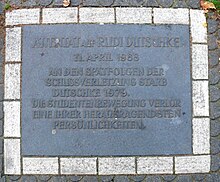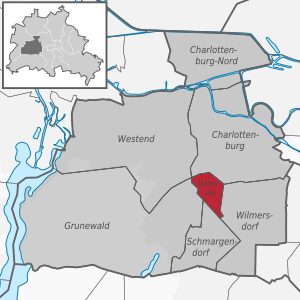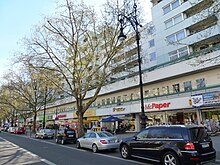Berlin-Halensee
|
Halensee district of Berlin |
|
|---|---|
| Coordinates | 52 ° 29 '53 " N , 13 ° 17' 47" E |
| surface | 1.27 km² |
| Residents | 15,627 (Dec. 31, 2019) |
| Population density | 12,305 inhabitants / km² |
| Postcodes | 10709, 10711 |
| District number | 0407 |
| Administrative district | Charlottenburg-Wilmersdorf |
Berlin-Halensee is the smallest district in the Berlin district of Charlottenburg-Wilmersdorf (and the second smallest in Berlin, after the Hansaviertel ), located at the western end of Kurfürstendamm . It was built as a villa and apartment complex at the end of the 19th century in the then still independent Berlin suburb of Deutsch-Wilmersdorf , with development and construction largely completed by 1914.
geography
location
Halensee lies on the plateau of the Teltow in the southwest of today's Berlin. The eponymous Halensee , which part of Grunewaldseenkette is located on the outer edge of the village area in the district of Grunewald .
expansion
The resolution of the District Assembly (BVV) of September 30, 2004 to establish the district defines the boundaries as follows:
“The district is roughly bounded by the Stadtbahn and Ringbahn . Eastern border axis: Cicerostraße – Hochmeisterplatz – Lehniner Platz – Damaschkestraße. [...] The area between the Bahngraben and the A 100 ring road has been reassigned to the Halensee district for reasons of building use and settlement structure . "
With this decision of the BVV, Halensee was separated from the Wilmersdorf district and raised to a separate district.
Neighboring districts
Halensee borders Charlottenburg in the east and north , Wilmersdorf in the southeast, Schmargendorf in the south and Grunewald and Westend in the west .
history
Named in 1880 after the lake of the same name , part of the Grunewald colony at the time, and driven by the opening of the Berlin-Grunewald ring station (today: Halensee station ), the district emerged as a villa and apartment complex at the end of the 19th century. The Halensee area quickly developed into a preferred place of residence for retired military officials, civil servants, writers and rentiers . By 1914 the development was practically complete.

In 1904 the terraces at Halensee, called Luna-Park from 1909 , opened at the time, the largest European amusement park based on the model of Coney Island in New York . The Lunapark experienced its heyday before the First World War. Due to inflation, the number of visitors fell sharply in the following years, although operations continued, the facility was in a desolate condition. In 1929, after a major renovation, it was reopened, but the operators could not follow up on old successes and the park was closed in 1934. Considered an eyesore by the Nazis, the entire site was demolished in 1935.
In the 1920s, many Russian emigrants settled in Halensee, as in neighboring Charlottenburg . For example, Vladimir Nabokov lived for many years at Nestorstrasse 22, where a memorial plaque is now attached.
Since 1923 the synagogue "Friedensstempel" Halensee was located at Markgraf-Albrecht-Straße 11/12 . During the Reichspogromnacht , fires were also started here by the National Socialists . In 1959 the building was torn down and replaced by residential buildings.


During the Second World War , the district was badly damaged. After the end of the war, many bomb holes were closed with social housing . Historic buildings from the pre-war years have been preserved in the area between the Ringbahn and the A 100 motorway ring road as well as in the side streets of Kurfürstendamm . On the Kurfürstendamm itself, the blocks between Westfälischer and Joachim-Friedrich-Strasse have largely been preserved, as have the corner houses on Markgraf-Albrecht- Strasse and Karlsruher Strasse .
Until 1970, the center of the Socialist German Student Union (SDS) with a meeting room and office was located in the house on the corner of Joachim-Friedrich- and Johann-Georg-Straße in a large Berlin apartment . Members of the SDS lived in other rooms.
About 30 meters away, the assassination attempt on the student leader Rudi Dutschke took place on April 11, 1968 in front of the property at Kurfürstendamm 141 . A plaque set in the sidewalk reminds of this today. During the Nazi era, there was an office for the “ General Plan Ost ” in the same building , which a stele in front of the house provides information about.
Culture and sights
Buildings

- The office building at Halensee, named “Lemon” by the Berliners, was built from 1994 to 1996 according to plans by Hilde Léon and Konrad Wohlhage on a plot of land directly on the busiest motorway section in Germany. The building is built according to ecological principles and has a two-shell outer skin, which provides a natural room climate and protects the house from the noise of the motorway and the exhaust gases. Until 2000 , AUBIS, involved in the Berlin banking scandal , resided here.
- The office building Kurfürstendamm 119/120 was built in 1994 according to plans by Helmut Jahn .
- The Hochmeisterkirche on Westfälische Strasse was built in the Romanesque style between 1908 and 1910 according to plans by Otto Schnock . After severe war damage, it was restored between 1953 and 1958 and consecrated again on October 31, 1958 by Otto Dibelius , the then Bishop of Berlin and Brandenburg.
- Built in 1904 and 1956 after war destructions rebuilt VW - Porsche -House at Kurfürstendamm 106 is a landmark in Halensee.
- The architects Johannes and Walter Krüger built the Holtzendorff garage on the corner of Holtzendorff and Heilbronner Straße in 1928/1929 , one of the few examples of these buildings in Berlin.
- The Kurfürstendamm Center , built in 1971/1972 by the architects Hinzpeter, Pingel, Doerr, is the dominant building on the western Kurfürstendamm. It extends over an entire block without making any reference to the traditional buildings on the boulevard. It is therefore one of the building sins of the 1970s on Kurfürstendamm, such as the now demolished Ku′damm-Eck (1970–1972) and the Ku′damm-Karree (1970–1975). After the Bauhaus hardware store chain moved out in 2013, the rooms could not be re-let, which meant that other shops had to close.
Streets and squares
traffic
The Ringbahn runs through the district with the lines S41, S42 and S46 with the stations Halensee and Hohenzollerndamm . Westkreuz train station is located directly on the district boundary in Charlottenburg. The light rail with the lines S5, S7 and S75 also crosses the district, but the stations Charlottenburg and Westkreuz are in the district of Charlottenburg.
The underground stations Wilmersdorfer Straße , Adenauerplatz and Fehrbelliner Platz of the underground line 7 are also in the immediate vicinity.
The bus lines M19, M29, X10 and the night line N10, which continue on Seesener Strasse to the Hohenzollerndamm train station, run over Kurfürstendamm. Lines 104 and N42 go through Westfälische Strasse to Halensee station, which is the central transfer station in the district. The BVG depot Cicerostraße is located on Cicerostraße in the Wilmersdorf district , which leads to a high volume of traffic for buses when changing shifts.
The through traffic in the direction of Grunewald and the city freeway with the entrance to the radio tower triangle has a high traffic density in both directions . There are therefore cycle lanes on Westfälische Strasse and Joachim-Friedrich-Strasse between Westfälischer Strasse and Kracauerplatz, but these are often blocked, especially on Westfälische Strasse.
Economy and Infrastructure
In addition to Kurfürstendamm, Westfälische Strasse is the most popular shopping street in the district with numerous small retail shops and restaurants.
In the pre- and post-war period, there were numerous automobile companies in Halensee, such as Wagenfabrik Jos. Neuss , Erdmann & Rossi and Rometsch , who have been building bodies on the basis of various car chassis since the beginning of the 20th century (many carriages were built here as early as the 19th century, Neuss was the market leader). There are still numerous car dealerships here with the associated workshops.
The Halensee S-Bahn station (until 1884: Grunewald station ) was given a pavilion-style station building after the original reception building was destroyed in World War II . The station was shut down soon after the Wall was built and used as a car salon for a while. In the course of the reopening of the Ringbahn , the station building was demolished in 1993. The former Halensee freight yard next to it was closed in the 1990s.

In 2006 the Bauhaus hardware store chain acquired the property in order to open a new specialist center here. In accordance with the requirements of the district, an architectural competition process was announced, in which the designs of the architectural office Müller & Reimann, Berlin prevailed. The designs envisage a city garden glass facade facing Kurfürstendamm, behind which the actual entrance is. New buildings were built for the around 20 medium-sized companies with up to 250 employees based on the property . The new center was opened on December 20, 2013.
Public facilities
- Consulate of the Republic of Gambia , Kurfürstendamm 103
- Embassy of the Republic of Sudan , Kurfürstendamm 151
- Association of Statutory Health Insurance Dentists Berlin, Georg-Wilhelm-Strasse 16
Sacred buildings
- Evangelical Hochmeisterkirche at Hochmeisterplatz
- Catholic St. Albertus Magnus Church , Nestorstrasse 10
- French Church in Berlin, Huguenot Church (French Reformed), Joachim-Friedrich-Strasse 4
- Synagogue "Temple of Peace" Halensee (destroyed), Markgraf-Albrecht-Straße 11/12
education
Elementary schools
- Halensee Elementary School, Joachim-Friedrich-Strasse 35/36
Universities of applied sciences
- Federal University of Applied Sciences for Public Administration, Social Insurance Department, Nestorstrasse 23-25
Others
- The Elektromote , the world's first trolleybus , operated in Halensee as early as 1882 .
- On September 29, 2005, the Artemis large brothel was opened in Halenseestrasse. It is barrier-free with 36 rooms, a pool, hammam , saunas, cinemas, bar and lounge.
Personalities
- Lale Andersen , chansonette and actress, lived at Cicerostraße 49 from 1941 to early 1945
- Albert Bassermann , actor, lived at Joachim-Friedrich-Strasse 54 from 1930 until he emigrated in 1933
- Heinz Berggruen , art collector, attended the Halensee primary school
- Hermann Brill , politician, lived at Karlsruher Strasse 13 from 1934 to 1938
- Salomo Friedlaender , philosopher and satirist, friend of the Dadaists , lived at Johann-Georg-Straße 20 from 1913 until his emigration in 1934
- Friedrich Hollaender , composer, lived at Cicerostraße 14 until he emigrated
- Else Lasker-Schüler , writer and poet , lived at Katharinenstrasse 5 from 1909 to 1911
- Soraya Esfandiary Bakhtiary , temporarily empress of Persia by marriage , lived as a child from 1933 to 1937 at Nestorstrasse 12
- Daniel Libeskind , architect, lived at Kurfürstendamm 96 during his time in Berlin until 2003
- Pierre Littbarski , national soccer player and world champion from 1990 attended the Halensee elementary school
- Lothar de Maizière , last Prime Minister of the GDR, Uwe Kärgel, Lore Maria Peschel-Gutzeit , Senator of Justice in Hamburg and Berlin a. D. and Karin Schubert , former Berlin Senator for Justice, run a law firm in Halensee
- Vladimir Nabokov , Russian writer and literary scholar, lived at Nestorstrasse 22 from 1922 until he fled from the National Socialists in 1937
- Helmut Newton lived in Halensee until he emigrated
- Ernst Reuter , who later became the governing mayor , lived at Lützenstraße 10 in 1913/1914
- Alfred Wegener , geophysicist, lived at Georg-Wilhelm-Strasse 9 from 1908 to 1909
- Klaus Wowereit , Governing Mayor of Berlin , lived in Halensee until the end of 2010
In addition, the following personalities live in Halensee: the actors Andreas Mannkopff , Peter Lustig , Ken Duken and Katja Riemann , the publisher Florian Langenscheidt , the editor Özgür Özata and the music professor Dieter Schnebel .
See also
- List of cultural monuments in Berlin-Halensee
- List of stumbling blocks in Berlin-Halensee
- List of streets and squares in Berlin-Halensee
- Lunapark (Berlin)
literature
- Christian Simon: Wilmersdorf - between idyll and metropolis . be.bra verlag, Berlin 2015, ISBN 978-3-8148-0210-7 .
Web links
- Walk in the neighborhood in Halensee
- BVV resolution to establish the district ( Memento of May 20, 2006 in the Internet Archive )
- Website of the Protestant Hochmeisterkirchengemeinde Halensee with a detailed article on the history of the church and its works of art
- Halensee / The Grunewald in the mirror of time
- The Halensee LOR page. In: Sozialraumdaten.kiezatlas.de. June 30, 2017, accessed February 24, 2018 .
Individual evidence
- ↑ Printed matter 02/02551 of the BVV ( Memento of May 20, 2006 in the Internet Archive )
- ↑ LDL Berlin: Hochmeisterkirche
- ↑ LDL Berlin: VW Porsche House
- ↑ LDL Berlin: Holtzendorff garage
- ↑ Patrick Goldstein: The two faces of the Kudamm. City West. In: Berliner Morgenpost . January 28, 2017. Retrieved April 24, 2017 .
- ^ Bauhaus, former Halensee freight yard. Lexicon: Charlottenburg-Wilmersdorf from A to Z. District Office Charlottenburg-Wilmersdorf of Berlin, accessed on August 4, 2014 .
- ^ Soraya Esfandiari Bakhtiari. Bakhtiari Family, accessed May 29, 2017 .






